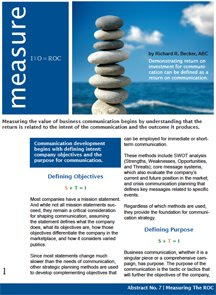
Advertising is long overdue for a transition and Anheuser-Busch is one marketer that seems to be on the front end of the change. While a recent article in AdvertisingAge focuses mostly on how Anheuser-Busch is changing its compensation model, there is something else in the air.
"Every time you have another agency work on a brand, the brand gets reinvented a little bit. We want partner agencies really tied to the strategy of a brand." — Keith Levy, vice president of marketing, Anheuser-Busch
He might have used different terms, but what Levy said falls lock step with the need for communication (advertising, marketing, public relations, and social media) to reinforce intent. Contrary to some advertising agencies, it is not enough to differentiate the advertising. It takes hard work.
How do you realize intent in communication?
Once the intent of communication is understood, its ability to be effective is dependent on three critical considerations: the effectiveness of the value proposition (message), the suitability of delivery (suitability), and the ability to reach the intended public (reach).
Let's start with the message.
The concept of a unique selling proposition or unique selling point was first introduced in the early 1940s by Rosser Reeves of Ted Bates & Company. His main concept was simple enough — drive home a central, research-based selling point that was powerful enough to convince customers to switch brands.
For the most part, it works. Head & Shoulders helps you get rid of dandruff. Olay gives you younger-looking skin. Red Bull gives you wings. And in all three cases, these messages come from the mission, market opportunities and product contrasts, and purpose of communication.
What happens when if they don't? They miss their opportunity to define what they do. For example, one of my favorite creative commercials missed communicating intent in 2000. The "Cat Herders" spot was memorable. But Electronic Data Systems (EDS), the client, not so much.
This challenge is not exclusive to advertising. We see it in public relations when people become focused on column inches over their public and publicity stunts go horribly wrong. We see it in social media when casual conversations lead to communication that the participants never intended and then overshadows everything else about them. Indeed, when a message lacks purpose, it's wasted communication.
On average, it takes 80 impressions before a message begins to stick (although I've seen figures that suggest it takes as many as 240 impressions in our communication cluttered world). And it takes 640 impressions to change an impression (given that it takes eight positive impressions that stick to undo one negative impression). Can you afford too many negatives?
Effective communication tends to reinforce the same consistent messages over and over again. That doesn't mean the message has to consist of the same words. But it does mean companies cannot afford to waste messages that do not include a value proposition. In other words, when that little flake is telling you something, an effective message leads you to one conclusion.
That's not to say that the value proposition concept doesn't have detractors. Some might argue that products are not all that unique (including me, unless we work harder to find real contrasts) so the value proposition only sells perception. After all, Head & Shoulders is no longer the only dandruff shampoo. And while that might be true, I might suggest where value propositions only erode over time because they were never meant to be permanent.
How can they? Messages do not just come from us. They are also delivered by what we say about others, what others say about us, and what our competitors or other stakeholders say about themselves in the market. If one message takes hold, then it requires adjustment at the strategic level not just the tactical.
Las Vegas recently provided an excellent example. The city's message conveys a party town atmosphere. It frequently takes an in-your-face attitude, even having a tuff or two with the NFL along the way. Recently, President Obama said Las Vegas is too lavish for business. Chicago immediately pushed the message that Chicago does not have such a stigma.
While I don't agree with the politics that created the situation, Las Vegas will still have to reconsider its message. Effective communication is never about control as much as it's about message management. When your value proposition becomes a negative, it needs to change. Of course, President Obama and Chicago might have to reconsider their messages too.
The bottom line, in terms of measuring communication, it that a strong message — one that breaks through the clutter while delivering a value proposition that reinforces intent — adds weight to the effectiveness of the communication. The right message is much more likely to deliver a better return on investment regardless of how it's delivered across various mediums.
How much better? When you think of Head & Shoulders, you might think of a dandruff solution. And when you think of EDS, you might think of herding cats. The message makes the difference.
Download The Abstract: Measure: I | O = ROC
The ROC is an abstract method of measuring the value of business communication by recognizing that the return on communication — advertising, marketing, public relations, internal communication, and social media — is related to the intent of the communication and the outcome it produces. Every Monday, the ROC series explores portions of the abstract.


















2 comments:
Awesome article! I have gradually become fan of your article and would like to suggest putting some new updates to make it more effective.
That's hilarious.
I think its worth leaving up as an example of spam, given this blog is updated daily. :)
Best,
Rich
Post a Comment